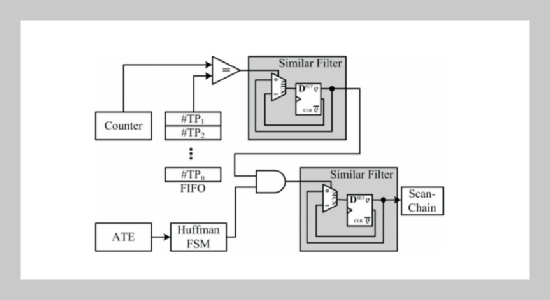REFERENCES
- [1] Hamzaoglu, I. and Patel, J. H., “Test Set Compaction Algorithms for Combinational Circuits,” IEEE Transactions on Computer-Aided Design of Integrated Circuits and Systems, pp. 957�963 (2000).
- [2] Lee, J. and Touba, N. A., “Combining Linear and Non-Linear Test Vector Compression Using Correlation-Based Rectangular Encoding,” Proceedings of the IEEE VLSI Test Symposium, Berkeley, CA, USA, pp. 252�257 (2006).
- [3] Wang, L. T., Wu, C. W. and Wen, X., VLSI Test Principles and Architectures: Design for Testability, San Francisco, CA, USA: Morgan Kaufmann (2006).
- [4] El-Maleh, A., “Efficient Test Compression Technique Based on Block Merging,” The Institution of Engineering and Technology Computers & Digital Techniques, Vol. 2, pp. 327�335 (2008a).
- [5] Hellebrand, S. and Würtenberger, A., “Alternating Run-Length Coding - A Technique for Improved Test Data Compression,” IEEE International Workshop on Test Resource Partitioning, Baltimore, MD, USA (2002).
- [6] Wu, P. H., Chen, T. T., Li, W. L. and Rau, J. C., “An Efficient Test-Data Compaction for Low Power VLSI Testing,” IEEE International Conference on Electro/ Information Technology, Ames, IA, USA, pp. 237� 241 (2008a).
- [7] Hamzaoglu, I. and Patel, J. H., “Reducing Test Application Time for Full Scan Embedded Cores,” International Symposium on Fault-Tolerant Computing, Madison, Wisconsin, USA, pp. 260�267 (1999).
- [8] Lee, K. J., Chen, J. J. and Huang, C. H., “Broadcasting Test Patterns to Multiple Circuits,” IEEE Transactions on Computer-Aided Design of Integrated Circuits and Systems, pp. 1793�1802 (1999).
- [9] Gonciari, P. T., Al-Hashimi, B. M. and Nicolici, N., “Variable-Length Input Huffman Coding for Systemon-a-Chip Test,” IEEE Transactions on ComputerAided Design of Integrated Circuits and Systems, Vol. 22, pp. 783�796 (2003).
- [10] Jas, A., Ghosh-Dastidar, J., Ng, M. and Touba, N. A., “An Efficient Test Vector Compression Scheme Using Selective Huffman Coding,” IEEE Transactions on Computer-Aided Design of Integrated Circuits and Systems, Vol. 22, pp. 797�806 (2003).
- [11] Kavousianos, X., Kalligeros, E. and Nikolos, D., “Multilevel Huffman Coding: An Efficient Test-Data Compression Method for IP Cores,” IEEE Transactions on Computer-Aided Design of Integrated Circuits and Systems, Sonoma, CA, USA, Vol. 26, pp. 1070�1083 (2007a).
- [12] Kavousianos, X., Kalligeros, E. and Nikolos, D., “Optimal Selective Huffman Coding for Test-Data Compression,” IEEE Transactions on Computers, Vol. 56, pp. 1146�1152 (2007b).
- [13] Nourani, M. and Tehranipour, M. H., “RL-Huffman Encoding for Test Compression and Power Reduction in Scan Applications,” ACM Transactions on Design Automtion of Electronic Systems, New York, NY, USA Vol. 10, pp. 91�115 (2005).
- [14] Tehranipoor, M., Nourani, M. and Chakrabarty, K., “Nine-Coded Compression Technique for Testing Embedded Cores in SoCs,” IEEE Transactions on VLSI Systems, Vol. 13, pp. 719�731 (2005).
- [15] Chandra, A. and Chakrabarty, K., “System-on-a-Chip Test-Data Compression and Decompression Architectures Based on Golomb Codes,” IEEE Transactions on Computer-Aided Design of Integrated Circuits and Systems, Vol. 20, pp. 355�368 (2001a).
- [16] Chandra, A. and Chakrabarty, K., “Test Data Compression and Test Resource Partitioning for Systemon-a-Chip Using Frequency-Directed Run-Length (FDR) Codes,” IEEE Transactions on Computers, Vol. 52, pp. 1076�1088 (2003).
- [17] El-Maleh, A., “Test Data Compression for Systemon-a-Chip Using Extended Frequency-Directed RunLength Code,” The Institution of Engineering and Technology Computers & Digital Techniques, Vol. 2, pp. 155�163 (2008b).
- [18] Sinaoglu, O., Bayraktaroglu, I. and Orailoglu, A., “Scan Power Reduction through Test Data Transition Frequency Analysis,” Proceedings of the IEEE International Test Conference, Washington, DC, USA, pp. 844�850 (2002).
- [19] Lai, N. C., Wang, S. J. and Fu, Y. H., “Low-Power BIST with a Smoother and Scan-Chain Reorder under Optimal Cluster Size,” IEEE Transactions on Computer-Aided Design of Integrated Circuits and Systems, Sonoma, CA, USA, Vol. 25, pp. 2586�2594 (2006).
- [20] Alpaslan, E., Huang, Y., Lin, X., Cheng, W. T. and Dworak, J., “Reducing Scan Shift Power at RTL,” Proceedings of the IEEE VLSI Test Symposium, San Diego, CA, USA, pp. 139�146 (2008).
- [21] Wang, S. and Gupta, S. K., “ATPG for Heat Dissipation Minimization during Test Application,” IEEE Transactions on Computers, Vol. 47, pp. 256�262 (1998).
- [22] Tseng, W. D. and Lee, L. J., “Reduction of Power Dissipation during Scan Testing by Test Vector Ordering,” IEEE International Workshop on Microprocessor Test and Verification, Austin, TX, USA, pp. 15�21 (2007).
- [23] Badereddine, N., Girard, P., Pravossoudovitch, S., Landrault, C., Virazel, A. and Wunderlich, H. J., “Minimizing Peak Power Consumption during Scan Testing: Test Pattern Modification with X Filling Heuristics,” Proceedings of the IEEE Design and Test of Integrated Systems in Nanoscale Technology, Tunis, Beijing, pp. 359�364 (2006).
- [24] Wang, S. J., Li, K. S. M., Chen, S. C., Shiu, H. Y. and Chu, Y. L., “Scan-Chain Partition for High Test-Data Compressibility and Low Shift Power under Routing Constraint,” IEEE Transactions on Computer-Aided Design of Integrated Circuits and Systems, pp. 716� 727 (2009).
- [25] Fang, H., Tong, C. and Cheng, X., “RunBasedReordering: A Novel Approach for Test Data Compression and Scan Power,” Proceedings of the Asia and South Pacific Design Automation Conference, Yokohama, Japan, pp. 732�737 (2007).
- [26] Chandra, A. and Chakrabarty, K., “Combining LowPower Scan Testing and Test Data Compression for System-on-a-Chip,” Proceedings of the IEEE Design Automation Conference, Las Vegas, NV, USA, pp. 166�169 (2001b).
- [27] Balakrishnan, K. J. and Touba, N. A., “Relationship between Entropy and Test Data Compression,” IEEE Transactions on Computer-Aided Design of Integrated Circuits and Systems, Sonoma, CA, USA, Vol. 26, pp. 386�395 (2007).
- [28] Jas, A. and Touba, N. A., “Test Vector Decompression via Cyclical Scan Chains and Its Application to Testing Core-Based Designs,” Proceedings of the IEEE International Test Conference, Yokohama, Japan, pp. 458�464 (1998).
- [29] Synopsys TetraMAX ATPG user guide version x2005.09.
- [30] Rosinger, P., Gonciari, P., Al-Hashimi, B. and Nicolici, N., “Simultaneous Reduction in Volume of Test Data and Power Dissipation for System-on-a-Chip,” Electronics Letters, Vol. 37, pp. 1434�1436 (2001).
- [31] Sankaralingam, R., Oruganti, R. R. and Touba, N. A., “Static Compaction Techniques to Control Scan Vector Power Dissipation,” Proceedings of the IEEE VLSI Test Symposium, Montreal, Que, Canada, pp. 35�40 (2000).
















